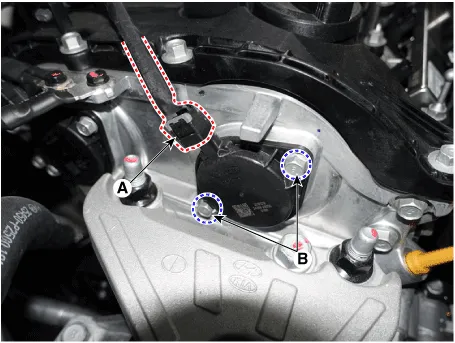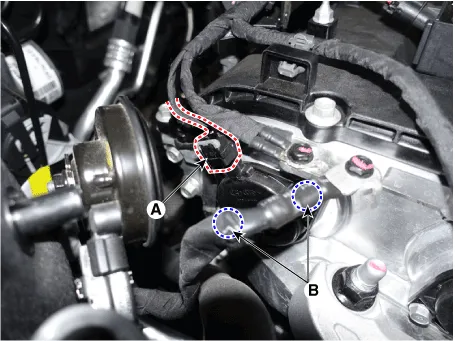Hyundai Santa Fe (TM): Engine Control System / Variable Force Solenoid (VFS). Repair procedures
| Inspection |
| 1. |
Turn the ignition switch OFF.
|
| 2. |
Disconnect the OCV connector.
|
| 3. |
Measure resistance between the OCV terminals 1 and 2.
|
| 4. |
Check that the resistance is within the specification.
|
| Removal |
| 1. |
Turn the ignition switch OFF and disconnect the battery negative (-)
cable.
|
| 2. |
Disconnect the CVVT oil control valve connector (A).
|
| 3. |
Remove the installation bolt (B), and then remove the valve from the
engine.
[Bank 1 / Intake]
[Bank 1 / Exhaust]
|
| Installation |
|
|
| 1. |
Installation is reverse of removal.
|
Circuit Diagram Harness Connector
Description Variable Intake manifold Solenoid (VIS) valve is installed on the intake manifold. The VIS valve controls the vacuum modulator which activates a valve in the intake manifold.
Other information:
Hyundai Santa Fe (TM) 2019-2023 Service and Repair Manual: Auto Defogging Actuator. Repair procedures
Inspection 1. Turn the ignition switch OFF. 2. Disconnect the auto defogging connector. 3. Verify that the auto defogging actuator operates to the open position when connecting 12V to terminal 3 and grounding terminal 6.
Hyundai Santa Fe (TM) 2019-2023 Service and Repair Manual: Front View Camera Unit. Repair procedures
Removal 1. Disconnect the negative (-) battery terminal. 2. Remove the inside rear view mirror cover (A) and front view camera cover (B). 3.
Categories
- Manuals Home
- Hyundai Santa Fe Owners Manual
- Hyundai Santa Fe Service Manual
- System settings
- Automatic Transaxle System (SBC)
- Engine Mechanical System
- New on site
- Most important about car



